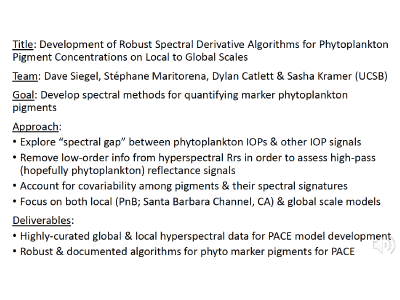Development of Robust Spectral Derivative Algorithms for Phytoplankton Pigment Concentrations on Local to Global Scales (2020)
The Plankton, Aerosol, Cloud, ocean Ecosystem (PACE) mission will provide unprecedented high spectral resolution ocean color observations with the potential to discover new insights into phytoplankton community dynamics on local to global scales. However, for many reasons, satellite ocean color algorithms designed to take advantage of hyperspectral data have lagged behind the development and application of multispectral algorithms. Here we propose to further develop and validate spectral derivative methods for quantifying the concentrations of marker phytoplankton pigments on local and on global scales, extending the approach of Catlett and Siegel [2018; JGR]. Spectral derivative methods have the advantage that they are, to some degree, insensitive to large spectral scale (>>100 nm) signals associated with issues of instrument calibration and atmospheric correction, as well as colored dissolved organic matter and detrital ocean optical properties. On the other hand, spectral phytoplankton absorption and backscatter features are found on spectral scales of ~10 to 100 nm. Spectral derivative methods have the potential to take advantage of this spectral gap in ocean optical properties so that concentrations of phytoplankton biomarker pigments can be accurately quantified.
Our goal is to develop and validate robust spectral derivative algorithms for phytoplankton biomarker pigments for NASA's upcoming PACE mission. We will develop these models using two data sets already in hand: 1) a synthesis of global scale observations data mined from the data repositories and the literature and 2) local scale observations from the Plumes and Blooms (PnB) program from the coastal waters of the Santa Barbara Channel, California. Statistical analyses of high performance liquid chromatography (HPLC) phytoplankton pigment concentrations show both similarities and differences in the groupings of pigments (cf., diatoms, picoplankton, etc.) derived for the two data sets due to the large degree of covariation among the pigments and the scales over which the data are assembled (which relates to the uniqueness of their information content). This suggests that there should be differences in global and local biomarker pigment algorithms created from these two data sets. Further, available hyperspectral observations come from a wide range of sources, sites, sampling protocols, analytical methods, and uncertainties. Thus, care needs to be taken in merging and applying these data to build useful and robust spectral derivative ocean color algorithms for biomarker pigment concentrations and their uncertainties.
Our work will contribute to the advancement of ocean color sciences beyond the development of robust, pre-launch phytoplankton biomarker pigment concentration algorithms for the PACE mission. First, we will create procedures for synthesizing hyperspectral field data that will come from a variety of data sources of varying quality. These protocols should be of great value to the PACE Science Team. Second, our approach will develop spectral derivative methods for both remote sensing reflectance and phytoplankton absorption, providing a test of the validity and a demonstration of the potential of the phytoplankton spectral gap hypothesis. Last, the simultaneous development of ocean color algorithms from the two data sets (global vs. local) will contribute to our understanding of how to maximize the information retrieved from satellite ocean color algorithms when switching one's focus from global to local scales.






